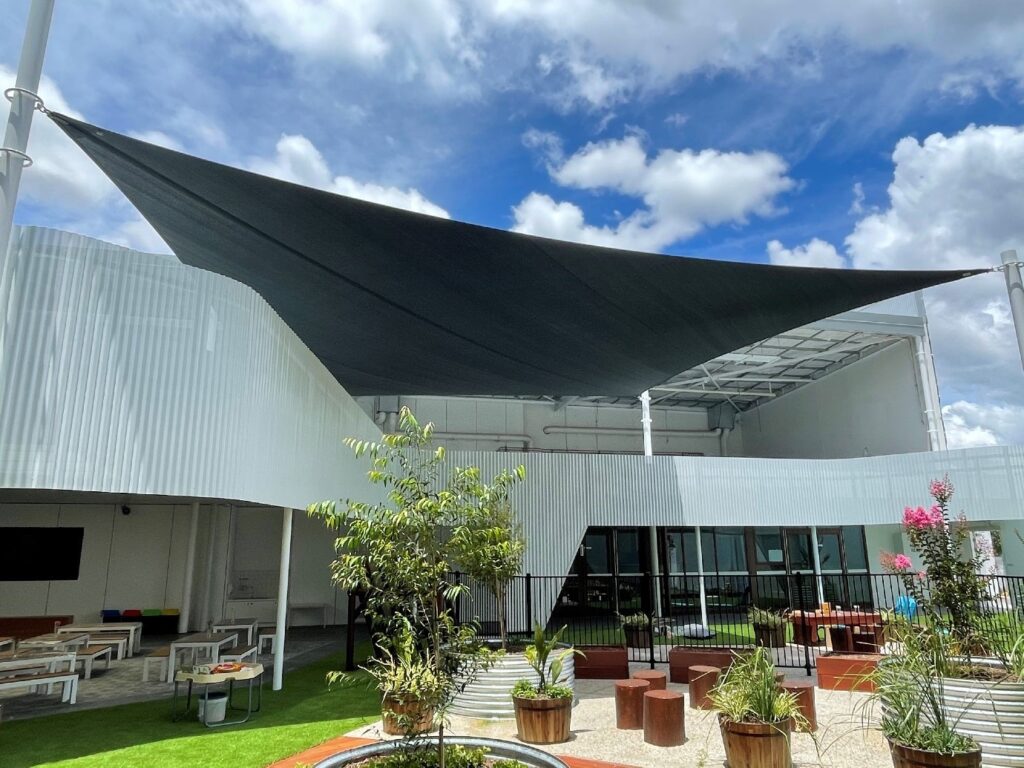YOU ARE HERE:

The 6 benefits of a fabric shade structure
Jamie Howard In Shade Structure
Fabric structures are often associated with temporary shading solutions, but they can be economical long-term solutions. With new and advanced fabric technologies as well as construction methods, it’s possible to create custom fabric structures that are long-lasting and can become a permanent architectural feature that adds to the overall aesthetic of your property.
Reputable manufacturers of commercial shades will work with you to create a custom industrial shade structure that can meet your requirements. Let’s explore the benefits:
An easy and cost-effective solution for covering wide-open and large spaces
Fabric structures are ideal for outdoor swimming pools and sports facilities for tennis, football, and rugby. They are also practical for amphitheatres, rail stations, sports stadiums, and other locations where massive public gatherings occur. Industrial applications, such as bulk storage facilities, aircraft hangars, and warehouses may also require custom fabric structures.
- Fabric structures offer an easy solution for large, wide-open covered spaces.
Architectural fabric structures requiring a large interior, wide-open spaces are known as clear span structures. They don’t require internal support columns for reinforcement in the middle of the structure because the high strength architectural fabric only weighs between 0.07 to 0.9 kilograms per square 0.093 meters.
The clear span width of an architectural fabric structure can range from 15 to 91 meters.
Many structures require the use of a clear span design, such as participative sporting facilities for football, soccer, tennis, baseball, and swimming pools; sports stadiums; amphitheatres; airport terminals; rail stations; churches; and other public gathering locations.
Many industrial applications such as warehouses, aircraft hangers, and bulk storage facilities also require a clear span structure. You can read more here about the difference between an industrial and commercial shade structure. If you have a need in your design for a wide space that is clear of posts and beams, an architectural fabric structure is a good choice.
- Fabric structures reduce construction and installation time.
The time required to design, manufacture, construct, and install a fabric structure is substantially shorter than that required for a conventional building. Many fabric structures are considered “pre-engineered” with most of the engineering already complete. The architectural fabric is prefabricated at the manufacturer and arrives at the job site in large panels, ready to cover thousands of square meters at one time. In addition, job site work, such as moving earth, pouring foundations and floor slabs, and erecting metal frames, can all take place at the same time as the production of the prefabricated panels.
- Fabric structures give you the opportunity to create one-of-a-kind, eye-catching, and high-profile structures.
Architectural fabric structures can be high-profile and designed to incorporate high peaks and sweeping lines. Fabric structures can also use a wide variety of coloured fabrics; in fact, PVC-coated architectural fabrics can be colour matched to meet any architect or building owners wishes. Often customers request a colour match to coordinate with corporate or school colours. Designs can include any number of different coloured fabrics used on the same structure, creating a dynamic appearance.
Almost clear and high-light transmission white fabrics can also be produced, which allow a lot of natural sunlight to enter during the daytime and produces a glow when the interior lights up at night. Many fabric structures incorporate both high-light transmission fabrics with panels of opaque fabrics. This allows for some sunlight while still controlling the amount of thermal gain.
- Fabric structures offer permanent, seasonal, or relocatable options.
Most architectural fabric structure designs are meant to be permanent. They can have an internal metal frame, use an internal mast and cables, or use only air to support the architectural fabric skin. The architectural fabric itself can last 20 to 30 years and be replaced with a new skin after that time, just like shingles or single-ply roof membrane. The metal frames, masts, and cables will last 50-plus years. Permanent fabric structures are frequently insulated with fiberglass or other lightweight insulation and must meet all local fire and safety codes, just like conventional buildings.
A great benefit of architectural fabric structures is the ability to design them to be seasonal or semi-permanent structures. Air-supported fabric structures can easily install over artificial sports turf fields to provide a recreational facility during the winter. The structures can come down in the spring and stored for the following season.
Architectural fabric structures designed to be permanent can also relocate to a new site if needed. This simply requires a foundation at the new location for reinstallation of the fabric skin and any supporting frame work.
- Fabric structures are cost-effective.
Architectural fabric structures are frequently more cost-effective to cover a given space, especially if a large clear span structure is required. The cost of a fabric structure will vary depending on the type of fabric structure you are considering; air-supported fabric structures and pre-engineered frame structures will cost less than a custom designed fabric structure. Other factors affecting cost include selection of the architectural fabric, the use of insulation, lighting, and HVAC systems. In all cases, when you do a side-by-side comparison of a conventional brick and mortar building to an architectural fabric structure of the same size, the fabric structure will always be a lower cost. In some cases, the savings could be as much as 50% or more.
- Fabric structures are energy-efficient and sustainable.
Architectural fabric structures have many sustainability benefits. The first factor to consider is that a fabric structure is extremely lightweight, enabling you to cover very large areas with very little mass. It takes less raw materials and less energy consumption to produce architectural fabrics and deliver them to the building site. That said, these architectural fabrics will last 20-plus years, so you get a long-life with low mass and energy consumption.
Many of the key parts of an architectural fabric structure are recyclable or reusable at the end of its life. For many of these structures, the majority of the mass is the metal frames or steel masts and cables. These metal parts (steel or aluminium) are easily recycled. Many of the architectural membranes are also recyclable, but more frequently these items are repurposed for other applications.
If properly designed, architectural fabric structures can be as energy efficient as conventional buildings. Designs with full insulation and significant translucent fabric panels allow plenty of daylight to enter the space and reduce lighting needs.
Consider an Architectural Fabric Structure for Your Next Project
Considering the benefits and the variety of structures available, a fabric structure is an excellent alternative to a brick and mortar building. It is ideal for large groups to gather under an enclosed space to work, play, watch, and socialize.
Share:
Jamie Howard - Director
Co-founder and Director Jamie has been hands-on in the shade and steel industry since leaving school. With over 15 years’ experience in shade, membrane and steel projects, Jamie is excited about the design opportunities shade structures offer in the commercial and industrial sectors. Jamie’s extensive design skills give him a competitive edge in situations with technical design complexity. He has won two personal industry awards for his designs, alongside many company-won awards.

